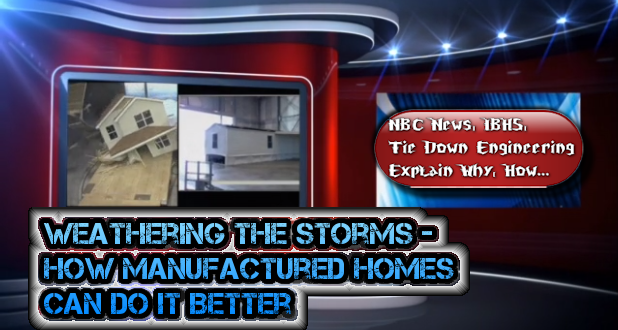“We have entered a new era of catastrophes. Either we pretend they will not happen to us, or we join forces to make resilience a national priority.”
— Zurich North America and the Wharton Risk Center’s recently released white paper for the Hurricane Katrina 10-year observance
By Jan Hollingsworth
for MHLivingNews
Say you live in a manufactured home in a little Midwestern town, and you hear sirens announce the approach of a small tornado with 100 mph winds.
What would you do?
- Go to the nearest roadside ditch, lay flat and cover your head.
- Run to your neighbor’s sturdy site-built home and take cover there.
- Stay where you are.
If you’re Dr. Tim Reinhold and your manufactured home is built to HUD Code Zone III wind specs on a permanent foundation, it’s a no-brainer: You stay put.
“That box is going to be built better than any site-built home, unless it’s built to hurricane standards,” says Reinhold, senior vice president of research and chief engineer for the Insurance Institute for Business & Home Safety (IBHS).
Reinhold has made a career of studying how structures of all kinds hold up to wind, and his work at IBHS has shattered many of the myths about modern manufactured homes.
That’s a good thing, because what you don’t know can kill you.
Memories of Masking Tape
Growing up in Miami during the 1960s, I came to view hurricanes as inevitable as the sun rising in the east.
Three storms in five years — Hurricane Donna (1960), Hurricane Cleo (1964), and Hurricane Betsy (1965) brought home the excitement of riding out Cat 3 winds in a sturdy stick-built 1920s-era home, a block from Biscayne Bay.
I remember staying up with my father, pacing from one room to the next, as the storms raged outside, pressing against the creaking plate glass picture windows he had “fortified” with a spider web of masking tape — the prescribed remedy at the time for fending off shattered glass.
Back then, no seemed to question how a few strips of tape was supposed to compensate for triple-digit winds, so masking the windows was a familiar and comforting ritual as we prepared for the coming storm.
It was an early lesson in the frailty of conventional wisdom and the false sense of security it can plant in the most rational of minds.
Decades later, as a newspaper reporter who chased storms for a living, that early lesson became a troubling epiphany.
Blown Away
On February 23, 1998, I followed the path of destruction blazed by the deadliest single weather event in the state’s history, when seven major tornadoes ripped through Central Florida.
It was the height of the winter tourist season and the Ponderosa RV park in Kissimmee, near Disney World, was annihilated by an EF3 twister that claimed more than half of the 42 lives lost that day.
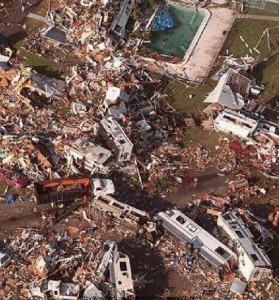
Surveying the wreckage of what had once been motor homes, travel trailers and vintage house trailers perched precariously on blocks, this seemed inevitable — almost expected. How could these fragile abodes possibly stand up to 135+ mph winds?
Everyone knew that “mobile homes” weren’t safe in a storm, just as everyone knew that plastering windows with masking tape would keep us safe from hurricane-force winds.
It was not until I reached the end of the 30-mile long swath carved out of the Central Florida landscape — at an upscale lakefront community filled with sturdy concrete, brick-and-mortar homes — that I came to realize the arrogance of assumptions, when confronted by the forces of nature.
What struck me first, as I stood before the ruins of what had once been a fortress-like home, was the sheer power of an EF3 tornado. The roof and most of the walls were missing and the foundation was littered with a jumble of broken concrete blocks.
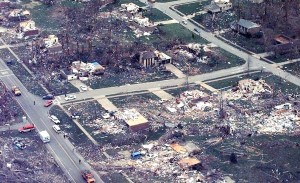
It looked like someone had set off a bomb. A big one.
The second revelation was the sheer randomness of the event. The house next door was untouched, not a shingle out of place, while across the street, another pile of broken concrete marked the former location of another half-million-dollar home.
You could follow the narrow and mercurial path of the storm through the community by the heaps of rubble on concrete slabs, the neighboring properties basking, intact, in the Florida sunshine.
The epiphany?
There is only one safe place to be in an EF3 tornado: underground.
A Better Box
On this point everyone seems to agree.
When it comes to the monster whirlwinds that exceed 135 mph, it matters little whether you are in an RV or a suburban site-built home. If you are in the path of an EF3, EF4 or EF5, you’re in a world of trouble if climbing into a bathtub is your only option.
The good news, says Reinhold, is that 93 percent of the nation’s tornadoes are EF 2 or below. Nonetheless, site-built homes constructed to the national standard of 90 mph are not engineered to stand up to even these smaller intensity storms.
Last year, the city of Moore, Okla. became the first in the nation to adopt tough new residential building codes designed specifically to prevent tornado damage.
New homes in Moore are to be built to withstand 135 mph winds, the upper range of an EF2 tornado.
Reinhold points out that manufactured homes built to HUD’s existing Zone III code — the hurricane standard used throughout most of Florida — already meet those criteria, if properly anchored on a permanent foundation.
That means that for a couple of thousand dollars more than the cost of a Zone I manufactured home, residents in tornado-prone areas around the country can have a safer, better-built box than a site-built home that costs twice as much, or more.
“We were surprised at the relatively small price difference between Zone I and Zone III homes,” Reinhold says. “The industry has a potential market there.”
The people of Moore were even more surprised to discover last year that some manufactured homes withstood even the monster EF5 tornado that prompted the new conventional housing building codes.
One such home, surrounded by devastation, became the focus of a YouTube testimonial for Oklahoma MH manufacturer Solitaire Homes, part of a broader look at this subject.
Lessons from Charley
Residents in the nation’s midsection have little reason to concern themselves with hurricanes, yet it was a hurricane that provided researchers with important insights into how to make a better box even better for everyone.
Charley, the first and most powerful of four hurricanes to strike Florida in a memorable six-week period in 2004, presented an exceptional research opportunity for the engineers at IBHS, a nonprofit organization that conducts independent research to identify and promote ways to strengthen homes and businesses in the face of natural disasters.
The Category 4 hurricane made landfall with sustained winds of 145 mph and gusts approaching 180 mph, toppling trees and power lines, ripping homes of all kinds apart as it churned across the state.
When Reinhold and his team studied the damage to manufactured homes, they found “a big difference” between how well Zone I, Zone II, and Zone III-code homes fared in the storm.
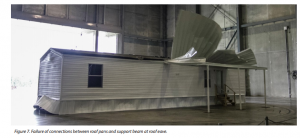
But more importantly, 80 percent of the damage manufactured homes sustained was linked to attached structures — carports, awnings, canopies and the like, according to the U.S. Department of Housing and Urban Development (HUD
These add-ons are typically built to lower construction standards than the manufactured homes themselves, and fail at lower wind speeds than the structure to which they’re attached, says Reinhold.
The field work and subsequent analysis in the wake of Charley, linked here, demonstrated that the failure of these structures often leads to damage to the host building, and also poses a threat to other buildings nearby.
“One of the big weaknesses was when people used these thin, flat pan-types of roofs,” says Reinhold, noting that a flaw in the manufacturers’ installation recommendations caused the add-on structures to fail at lower wind speeds than they should have.
Last year IBHS engineers conducted wind tests at its South Carolina research center, where NBC News documented the impact of hurricane-force winds on a manufactured home with a carport.
In one test, the thin pan carport roof buckled and took the roof of the home with it, peeling it off and leaving the open “box” exposed to the raging simulated storm — even though the carport was installed to manufacturer’s specifications.
“It’s something they need to change their design guidance on,” he says. “It’s a physical reality versus a mathematical computation.”
In another test, the team modified how the carport was attached, and both the add-on structure and the house held up under the same wind stress that buckled the structures in the first test.

The IBHS research was also applicable to site-built homes with weak add-ons, according to the company’s report. And it produced useful information for insurers like American Modern, the company that sponsored the high wind tests, as well as manufactured homeowners who have a crucial stake in protecting their families and property.
Minimizing Risk

It begins with a better box, and despite widespread misconceptions, modern manufactured homes are built as well — or better — than most site-built homes, according to U.S. Department of Housing and Urban Development, which governs the nation’s HUD code requirements.
Today you can buy a manufactured home that’s stronger than a standard $300,000 house — and it will stay there long after the storm took the other one away, says Knute Chauncey, national sales manager at Tie Down Engineering.
“When you build something in a factory and have a government agent looking over your shoulder and putting a tag on something that’s the least bit crooked — you would think that would be a better option all around,” Chauncey says.
Yet the stigma of the so-called “mobile home” persists, perhaps because so many of the old pre-HUD
code house trailers are still very much in use — nearly 40 years after the last mobile home rolled off the production line in 1976.
These are the stars of the disaster aftermath stories on the evening news — the vulnerable old relics propped up on blocks, or newer models not properly anchored — all left to the mercy of the storms.
HUD’s federal wind zone standards determine what kind of manufactured home is to be used in different parts of the country, and officials are looking closely at raising the required code in Tornado Alley, where the frequency and intensity of twisters is on the rise.
“There is a government task force working on changing wind zones because of new weather patterns the last few years, through the center of the country,” says Chauncey.
In addition to the federal MH codes for wind resistant construction, each state also has specified standards for how a home is to be installed and tied down, depending on soil type, local weather patterns and other factors.
If you have the right home in the right zone, the key then becomes how the home is “set” or anchored, says Chauncey, who has specialized in MH tie downs for the past 13 years. “If you don’t set it right from the get-go, you can’t expect anything else to hold properly,” he says. Most states now watch it pretty carefully.”
Weighing 30 tons or more, with elaborate anchoring to permanent foundations, today’s manufactured homes are meant to be anything but mobile, yet they are built to withstand high-speed transport from factory to their final destination — another testament to their durability, says Laurie Mercurio of the Wisconsin Housing Alliance.
“These homes are inherently stronger. They not only travel on expressways, they have to go down exit ramps and negotiate roundabouts,” she says.
The research at IBHS aims to make them stronger still, with its FORTIFIED Home™ program — a set of engineering and building standards that go beyond minimum codes, and are designed to reduce damage from specific natural hazards, depending on locale.
Manufactured homeowners can retrofit their homes to earn a bronze, silver or gold FORTIFIED Home certification for hurricane, hail and high-wind risks that can add safety and value to their homes.
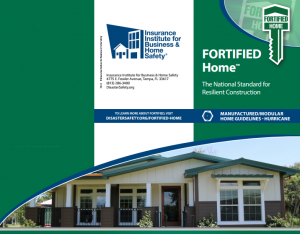
Sealed roof decks, structural sheathing and connections between roofs, walls, floors and foundations are among the components addressed by the IBHS FORTIFIED program.
“One of the things that did come out of the testing and reporting on our high wind research is it gave us the opportunity to talk to manufacturers about our findings,” says Reinhold.
In August, Palm Harbor Homes’ factory in Plant City, Fla. became the first plant in the nation to receive a FORTIFIED Home–Hurricane certification to produce modular homes.
“Offering homeowners safer, stronger homes in hurricane-prone areas will significantly reduce their risk of property damage and provide them peace of mind,” IBHS FORTIFIED Programs Manager Fred Malik said, when Palm Harbor unveiled its new Discovery Florida line.
While these custom modulars fall in the upper price range of factory-built homes, resilient construction does not have to be cost-prohibitive for homeowners of modest means.
In many cases, the cost of retrofitting older manufactured homes or upgrading the initial set-up of new ones may be mitigated by higher resale values and lower insurance premiums.
For those who dwell in storm-prone regions, it can be a case of pay now to properly install a home, or pay later in damage.
“The government and the industry as a whole have made great strides in how to do these things — and do them right,” says Chauncey. ##

(Editor’s Notes: For those who want a snap shot of the evolution of ‘trailer houses,’ to ‘mobile homes,’ to manufactured homes, please see the article, linked here.)
 manufacturedhomelivingnews.com Manufactured Home Living News
manufacturedhomelivingnews.com Manufactured Home Living News
